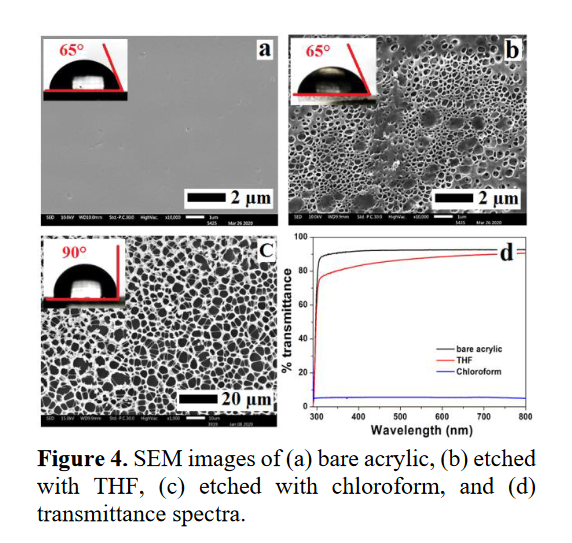Influence of annealing and etching on physical and wetting properties of acrylic surface
DOI:
https://doi.org/10.53848/ssstj.v10i2.546Keywords:
Acrylic, Tetrahydrofuran, Wettability, Annealing, EtchingAbstract
The objective of this research aims to study the surface modification of acrylic for superhydrophobic applications. The acrylics were modified using annealing at 50, 75 and 100 °C for 1 h. To evaluate the effect of etching on the morphology of acrylic substrates, two different acids between tetrahydrofuran (THF) and chloroform with their concentration of 99.8 % v/v were used to etch for 1 min. Then, the annealed acrylics were etched by THF because chloroform has highly hazardous acid and low transparency after etching. The effects of annealing and wet chemical etching on morphology, optical properties and wettability can be characterized using atomic force microscopy, scanning electron microscopy, Vickers hardness tester, UV/Vis spectroscopy and water contact angle measurement. This result exhibits that the hardness of acrylic increases with the increase of annealing temperature. Furthermore, the wet chemical etching has direct affected to the wettability of acrylics due to the increasing of surface roughness.
References
Aadila, A., Afaah, A. N., Asib, N. A. M., Mohamed,R., Rusop, M., & Khusaimi, Z. (2016). Effect of annealing temperature on the morphology and optical properties of PMMA films by spin-coating method, AIP Conference Proceedings,1733, 020045. doi:10.1063/1.4948863
Al-Qahtani, M., & Haralur, S. B. (2020). Influence of different repair acrylic resin and thermocycling on the flexural strength of denture base resin. Medicina, 56(2), 50.doi:10.3390/medicina56020050
Ebert, D., & Bhushan, B. (2012). Transparent,superhydrophobic, and wear-resistant coatings on glass and polymer substrates using SiO2, ZnO, and ITO nanoparticles. Langmuir,28(31), 11391-11399. doi:10.1021/la301479c
Hiratsuka, M., Emoto, M., Konno, A., & Ito, S.(2019). Molecular dynamics simulation of the influence of nanoscale structure on water wetting and condensation. Micromachines,10(9), 587. doi:10.3390/mi10090587
Jumrus, N., Chaisen, T., Sriboonruang, A.,Panthawan, A., Kumpika, T., Kantarak, E., …Thongsuwan, W. (2020). A facile methodology to make the glass surface superhydrophobic. Materials Letters, 264,127347. doi:10.1016/j.matlet.2020.127347
Jumrus, N., Jompeang, J., Panthawan, A., Kumpika,T., Wiranwetchayan, O., Sanmuangmoon, P.,… Thongsuwan, W. (2021). Transparency and water resistance of a superhydrophobic acrylic surface prepared using THF/IPA etching-assisted SiO2 NPs. Materials Letters, 304, 130618. doi:10.1016/j.matlet.2021.130618
Kaczmarek, H., & Chaberska. H. (2006). The influence of UV-irradiation and support type on surface properties of poly(methyl methacrylate) thin films. Applied Surface Science, 252(23), 8185-8192.doi:10.1016/j.apsusc.2005.10.037
Khodabakhshi, F., Kazeminezhad, M., Azarnush,M., & Miran, S. H. (2011). Effect of post annealing treatment on nano-structured low
carbon steel sheets processed by constrained groove pressing. Materials Science Forum, 667-669, 1009-1014. doi:10.4028/www. scientific.net/MSF.667-669.1009
Kim, S. M., Park, S. B., Bedair, T. M., Kim, M. H.,Park, B. J., Joung, Y. K., & Han, D. K. (2017).The effect of solvents and hydrophilic additive
on stable coating and controllable sirolimus release system for drug-eluting stent. Materials Science and Engineering C, 78, 39-46. doi:10.1016/j.msec.2017.04.024
Mohajerani, E., Farajollahi, F., Mahzoon, R., & Baghery, S. (2007). Morphological and thickness analysis for PMMA spin coated films. Journal of Optoelectronics and Advanced Materials, 9(12), 3901-3906.
Moldoveanu, S. C., & David, V. (2017). Selection of the HPLC method in chemical analysis.Amsterdam: Elsevier.
Nayak, A. P., Islam, M. S., & Logeeswaran, V. J.(2012) Wet etching. In B. Bhushan (Ed.),Encyclopedia of nanotechnology.doi:10.1007/978-90-481-9751-4_431
Sriboonruang, A., Kumpika, T., Kantarak, E., Sroila,W., Singjai, P., Lawan, N., … Thongsuwan,W. (2019). Isomer effect on chemical reactivity and superhydrophobicity of chlorosilane modified SiO2 nanoparticles prepared by one-step reaction. Materials Letters, 248, 227-230.
Wu, H., Xu, D., Yang, M., & Zhang, X. (2016).Surface structure of hydroxyapatite from simulated annealing molecular dynamics simulations. Langmuir, 32(18), 4643-4652.doi:10.1021/acs.langmuir.5b04667
Wu, R., Chen, R., Gao, Y., Zhang, G., Xiao, L., & Jia, S. (2013). Annealing temperature dependence of the nanosized pits on poly(methyl methacrylate) surface. Japanese Journal of Applied Physics, 52, 125501.doi:10.7567/JJAP.52.125501
Yeh, S. C., Wu, C. H., Huang, Y. C., Lee, J. Y., & Jeng, R. J. (2019). In search of a green process:Polymeric films with ordered arrays via a water droplet technique. Polymers, 11(9), 1473.doi:10.3390/polym11091473
Zhang, Y., Dong, B., Wang, S., Zhao, L., Wan, L., & Wang, E. (2017). Mechanically robust, thermally stable, highly transparent superhydrophobic coating with low-temperature sol–gel process. RSC Advances, 7, 47357-47365. doi:10.1039/c7ra08578h

Downloads
Published
How to Cite
Issue
Section
License
Copyright (c) 2023 Suan Sunandha Rajabhat University

This work is licensed under a Creative Commons Attribution 4.0 International License.











